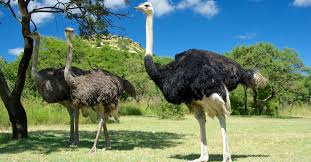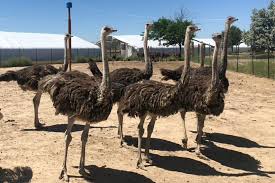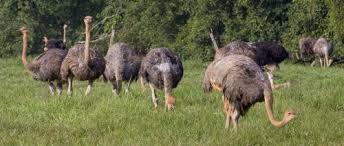![]()
If you’ve landed on this article page, you’re probably searching for a
good business idea—an idea that’s light on the pocket but heavy on
returns, promising both a fulfilling journey and potential profit.
|
How
To Become an Ostrich Farmer in Nigeria
Raising ostriches for resources such as meat, hides, feathers
and eggs can be a profitable way to earn a living. If you're
interested in pursuing this agricultural venture as a new
career, it can be helpful to understand what the job entails and
what it requires from its practitioners.
Find a veterinarian
Before starting your farm, locate and speak with a veterinarian
who can provide routine and emergency medical care to your
ostriches. A veterinarian is important for maintaining the
health and happiness of your birds. Make sure that the medical
care available in your area can accommodate large birds, such as
ostriches. Ideally, find a livestock veterinarian who can visit
your premises.
An investor who really wants to go into this business will need
at least half plot of land. The land should be fenced only to
prevent the birds from moving away on their own from the farm.
Ostrich farmers raise ostriches as livestock to produce
commercial goods like feathers, eggs and meat. The career may
appeal to people interested in earning a high income while
engaging in a more sustainable type of farming.
If you want to become an ostrich farmer, spend some time
learning about ostriches, decide which commodity you'd like to
specialize in, prepare the land you plan to raise the ostriches
on and consider your options for feeding them.
Farmers may choose to raise these animals to produce commercial
goods such as:
Feathers
Raising ostriches for feathers can be a sustainable form of
livestock farming since the feathers grow back and feather
cutting presents no harm to the animal. Many consumers prize
ostrich feathers for their utility as dusters, owing to their
natural ability to attract dust. They also have decorative
value, and fashion and costume designers commonly purchase
ostrich feathers to embellish garments.
Hides
A hide is the skin of an animal, often used for making leather.
Ostrich hides are distinctive because of their dappled
appearance, marketable qualities and high yield potential, with
a single ostrich being capable of producing 50 square meters of
leather. Leather produced with ostrich hides is typically soft,
flexible and durable. These qualities, in addition to the
distinctive appearance, contribute to the status of ostrich
hides as a luxury commodity. Indeed, several high-end fashion
houses produce bags, shoes, jackets and other accessories with
ostrich leather.
Eggs and meat
Ostrich eggs, equivalent in volume to over 20 chicken eggs, are
often sold emptied for decoration or craft projects, though some
farms may sell edible eggs for consumption. Ostrich meat is
commercially available as food, often promoted for its leanness
and similarity in taste to beef. Ostriches produce red meat that
is significantly lower in fat and cholesterol than in other
animals.
Ostriches have a better feed conversion ratio than cattle
A feed conversion ratio is a measure of how efficiently a
livestock animal converts the resources it consumes to the
desired commodity. The lower the ratio, the more efficient the
animal is. Compared to beef cattle, another hide- and red
meat-producing livestock animal, ostriches consume fewer
resources relative to the resources they produce. The former has
a feed conversion ratio of around six, meaning that it requires
around six pounds of feed to produce one pound of a commodity.
In contrast, ostriches have a ratio of around 3.6:3.9, showing
that they require fewer resources to raise.
Ostrich farming is relatively sustainable
A sustainable method of farming is one that allows a generation
of people to meet their needs without significantly depleting
the resources required for the needs of future generations. The
smaller feed conversion ratio of ostriches means that they have
a much smaller impact on the environment. Compounded with their
smaller space requirements, this helps to make ostriches a much
more sustainable choice for livestock farming.
Ostrich commodities can be profitable
A couple of factors lend to the potential profitability of
ostrich farming. One is the luxury or novelty value of ostrich
commodities, particularly hides, feathers and meat. The meat may
be an attractive food item for health-conscious consumers or
those interested in trying something new. The feathers and hides
have consistent buyers in the fashion industry, and feathers
have additional uses as dust removal tools in the automobile and
home goods markets. Other parts of the bird, such as the eyes
and the feet, may even have medicinal uses.
The ostrich is very adaptable and thrives under extreme
conditions. Your ostrich may outlive you! It can live for up to
100 years and can remain productive i.e. laying eggs for up to
45 years. The ostrich hen can lay between 30 and 100 eggs per
year with an average of 45-50 eggs. The ostrich lays the largest
egg of any living bird
Another factor is the scarcity of supply relative to comparably
high demand. Most livestock farmers raise cows, pigs or
chickens, but an increasing number of consumers are looking for
alternative sources of protein, and many are interested in novel
commodities such as those provided by ostriches. To offer
ostrich-based goods in such a market allows a farmer to enjoy
relatively little competition while reaching a fairly large and
diverse audience.
Why Every Livestock Farmers Should Consider OSTRICH Farming
Profitability-: The egg
of an ostrich could sell for as much as $500 in the
international market.
Now imagine that you sell just 10 of that in 1 month and
that is a very prudent estimation considering the increasing
popularity of ostrich farming. We have fertile ostrich eggs in
stock available to any farmers that need it. Also, a live
ostrich in the international market sells for as much as $5,000
per one which is a whole lot of money.
High Return on
Investment (ROI) -: You would also recoup your investments on
ostrich farming faster than even pig farming or cattle farming.
A single ostrich can produce as many as 60 eggs yearly and
within 14 months, the chicks can grow to reach market size.
LOCATION-: Hey! Ostriches are very fast runners. They love to
run so you must first provide a small space or very large sparse
of land to breed them in and also fence it in to prevent them
from running away. Also, ostriches can grow as tall as 9 feet
so, if you want to build a shelter for them, you should put
their heights into consideration. Another thing to put into
consideration is water because ostriches drink a lot of water.
You can choose a location close to a stream or build an
artificial pond or borehole to allow for access to adequate
water supply.
BREEDING-:
Because of the huge start-up costs, it is advisable for
anyone who wants to go into ostrich farming to start on a lower
scale. You should start with at least 1 male ostrich and a
female ostrich. Due to the high level of production of
ostriches, you would have your hands full in no time. So, you
shouldn’t be scared of starting small.
. FEEDING-: You can feed your ostriches on any poultry feed,
fruits, tubers, grains, leaves and even small animals. You could
also buy specially formulated feed for them to promote growth
and productivity.
5. HEALTHCARE-: Although ostriches have a very strong immune
system and are less likely to fall ill, it wouldn’t hurt to have
a veterinary doctor on hand to be in charge of caring for their
health and ensure that you include these costs in your income
statement.
6. NETWORKING-:
Ostrich farming is a unique business and not as popular as other
livestock farming businesses and as a beginner, you might find
yourself in a confused state sometimes. This is why you need a
lot of networking to successfully run an ostrich farming
business. You should consider joining internet forums, watching
YouTube videos and joining groups or unions of ostrich farmers
if you can find any in your locality. There is no limit to what
you can learn from other experienced ostrich farmers.
|







